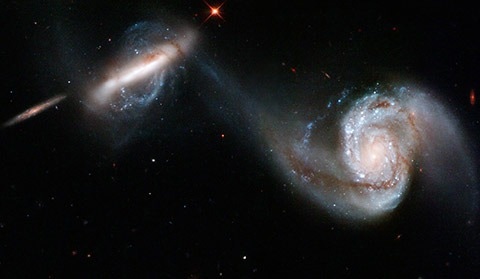A new study performed under the guidance of the University of Southampton has disclosed the reason behind how supermassive black holes (SMBHs) feed off of gas clouds. These clouds reach them by traveling hundreds of thousands of light years from one galaxy to another.

Two interacting galaxies viewed from the Hubble Space Telescope: Image Credit: NASA/ESA/Hubble Heritage Team.
An international research group has demonstrated that there is a vital link between the interaction of neighboring galaxies and the vast amount of gas required to “fuel” such huge, super-dense, space phenomena. Their study findings have been reported in the Nature Astronomy journal.
Black holes are created when a star collapses, squeezing matter into a comparatively small space. This raises the force of gravity to a level where nothing can escape, not even light—thus the name.
Some black holes have masses millions of times greater than the sun, ejecting huge amounts of energy. These are called “supermassive black holes,” and it is still mysterious how exactly they are developed or gain sufficient fuel for themselves to be powered.
Supermassive black holes fuel their activity by, in part, the gradual accumulation of gas from the environment around them. Supermassive black holes can make the centers of galaxies shine very brightly when they capture gas and it’s thought this process can be a major influence on the way that galaxies look today.
Dr Sandra Raimundo, Study Lead Researcher and Astrophysicist, University of Southampton
Raimundo added, “How SMBHs get enough fuel to sustain their activity and growth still puzzles astronomers, but the work we have carried out provides a step towards understanding this.”
The Southampton researcher, collaborating with scientists at the universities of Copenhagen and California, utilized data gathered from the 4-m Anglo-Australian telescope in New South Wales, Australia, to learn about the orbits of gas and stars in a huge sample of over 3000 galaxies.
They determined those with the existence of what is called “misaligned” gas—put differently, a gas that rotates in varied directions from the stars in the galaxy, signaling a past galaxy interaction. Further, they discovered that galaxies with misaligned gas consisted of a greater fraction of active supermassive black holes.
A clear link between misaligned gas and supermassive black hole activity was shown by the outcomes. This shows that the gas has been moved where two galaxies come in contact with each other, meanders vast distances via space, and further succumb to the large gravitational forces of the supermassive black hole. This has been pulled in and swallowed up as a crucial source of fuel.
For a long period of time, astronomers have suspected that a merger with another galaxy can offer this source of gas, but direct proof of this has been elusive.
The work that we carried out shows the presence of gas that is misaligned from stars is associated with an increase in the fraction of active supermassive black holes. Since misaligned gas is a clear sign of a past interaction between two galaxies, our work shows that galaxy interactions provide fuel to power active supermassive black holes.
Dr. Sandra Raimundo, Study Lead Researcher and Astrophysicist, University of Southampton
Raimundo added, “This is the first time that a direct connection has been observed between the formation and presence of misaligned gas and the fueling of active supermassive black holes.”
Dr. Marianne Vestergaard, a co-author in the study, highlighted, “What is exciting about these observations is that we can now, for the very first time, identify the captured gas and trace it all the way to the center where the black hole is devouring it”.
At present, the researchers want to extend their research and use their outcomes to evaluate how much of the total mass of supermassive black holes increased from this mechanism and how significant this was considered in the early Universe.
Journal Reference
Raimundo, S. I., et al. (2023) An increase in black hole activity in galaxies with kinematically misaligned gas. Nature Astronomy. doi.org/10.1038/s41550-022-01880-z.